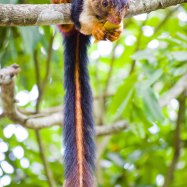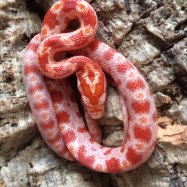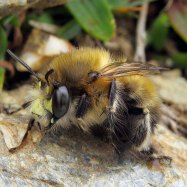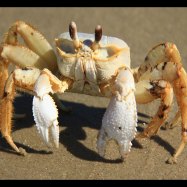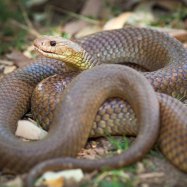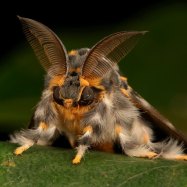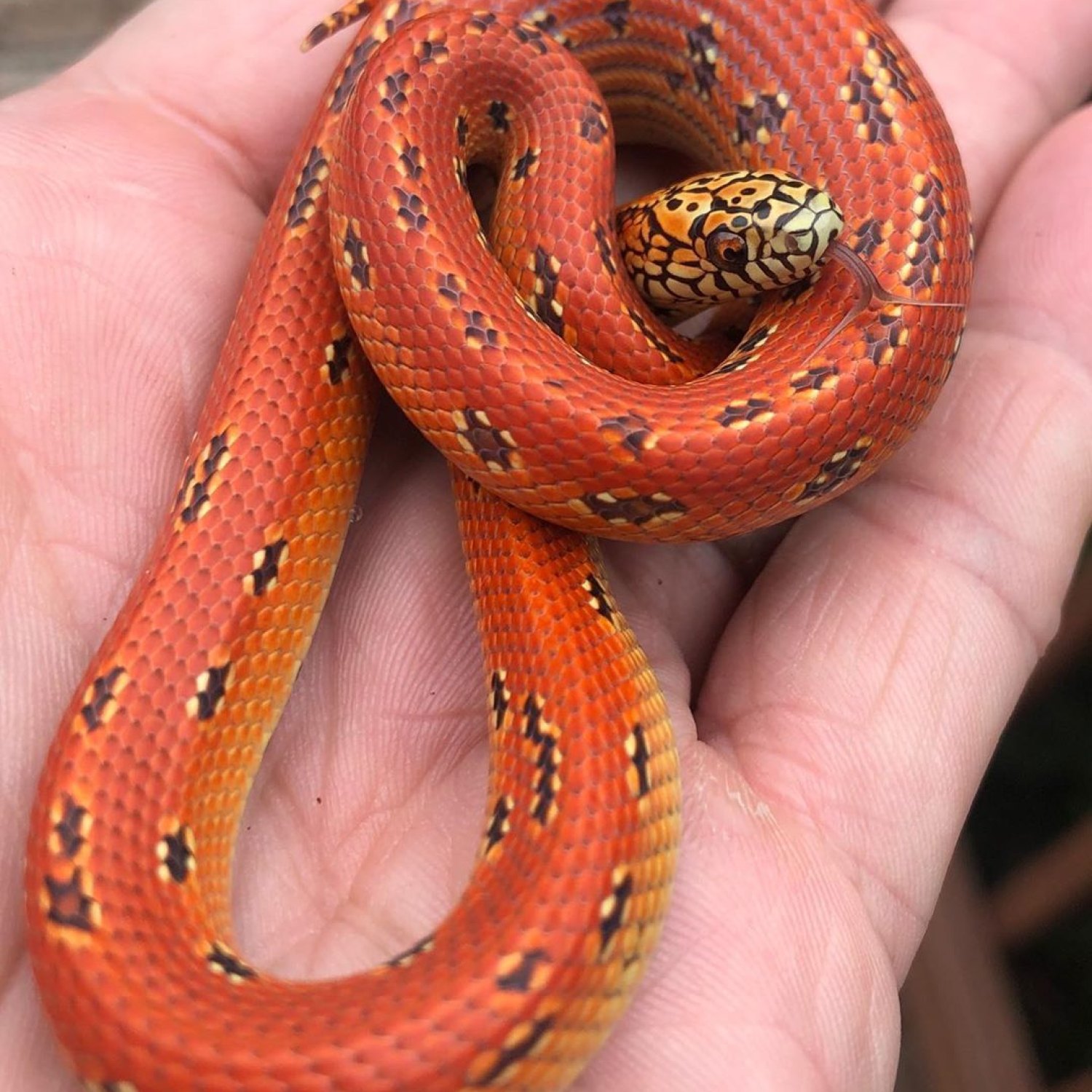
Desert Kingsnake
2-4 feet (61-122 cm)
The Desert Kingsnake, found in the desert areas of Arizona, Texas, New Mexico, and Mexico, is a stunning and adaptable creature. With a length of 2-4 feet and a long, slender body, it belongs to the Colubridae family. Its striking coloration and efficient hunting skills make it a top predator of the desert ecosystem. #DesertKingsnake #AnimalsD #Colubridae
Animal Details Summary:
Common Name: Desert Kingsnake
Kingdom: Animalia
Habitat: Desert regions
The Majestic Desert Kingsnake: A Closer Look at this Striking Reptile
The desert regions of the Southwestern United States and Northern Mexico are home to a creature known for its incredible beauty and unique adaptation to its habitat - the Desert Kingsnake. Scientifically known as Lampropeltis getula splendida, this reptile is a member of the animal kingdom, Chordata phylum, and the reptilia class, and is part of the squamata order and colubridae family. With its striking coloration, long and slender body, and carnivorous feeding method, the Desert Kingsnake is truly a fascinating creature that deserves a closer look.An Adaptation to the Desert
As its name suggests, the Desert Kingsnake is best known for its ability to thrive in arid, desert regions Desert Kingsnake. These areas pose many challenges for survival, such as extreme temperature fluctuations, scarce food sources, and limited water supply. However, this powerful snake has evolved to adapt to these harsh conditions.One of the most noticeable adaptations of the Desert Kingsnake is its coloration. The species has a reddish-brown or olive-brown background color with black or dark brown bands. Though this coloration may seem similar to other snake species, it serves a specific purpose in the desert. The dark bands help the snake to blend in with its surroundings and remain camouflaged from predators. The lighter colors also help reflect sunlight, keeping the snake cooler in the scorching desert heat.
A Carnivorous Predator
Another remarkable aspect of the Desert Kingsnake's adaptation to the desert is its feeding method. As a carnivorous predator, this snake primarily feeds on other reptiles, including smaller snakes, lizards, and even other Kingsnake species Dromornis Stirtoni. Its diet also includes rodents and birds, making it a top predator in its habitat.The Desert Kingsnake is equipped with powerful jaws and sharp teeth, enabling it to capture and subdue its prey. It is also an opportunistic hunter, meaning it will eat almost anything it comes across, making it a valuable member of the ecosystem. Its hunting skills and diverse diet play a crucial role in regulating the populations of other animal species in the desert.
A Prominent Presence in the United States and Mexico
The Desert Kingsnake can be found in several desert areas throughout the Southwestern United States and Northern Mexico. Its geographical distribution includes states such as Arizona, Texas, and New Mexico, as well as Northern Mexico. This widespread presence makes the species a renowned and easily recognizable reptile in the region.In the United States, the Desert Kingsnake can be found in various regions, including the Sonoran and Mojave deserts. In Mexico, its range extends into the Chihuahuan Desert and the Sonoran Desert. This extensive distribution not only showcases the adaptability of this creature, but also serves as an indicator of the health of its ecosystem.
A Close Look at its Physiology
The Desert Kingsnake has a distinctive body shape, with an elongated and slender body that is well-adapted for movement on sandy and rocky desert terrain. The species has a smooth, glossy skin, with its scales arranged in distinct patterns, adding to its visual appeal.On average, the Desert Kingsnake can reach a length of two to four feet (61-122 cm). However, there have been reports of some individuals growing up to six feet (183 cm) long. This impressive size makes it one of the largest species in the Kingsnake family.
The Fascinating World of the Kingsnake
Aside from the Desert Kingsnake's physical features and ecological significance, the species also has several interesting behaviors. One of the most well-known behaviors of the Kingsnake family is their ability to constrict their prey. This involves wrapping their bodies around their prey and squeezing until the animal suffocates. The Kingsnake's powerful muscles make it extremely skilled at this method of hunting.Another intriguing behavior of the Desert Kingsnake is its tendency to rattle its tail when threatened. This mimics one of its most famous predators, the rattlesnake, and serves as a warning signal to potential predators to stay away. This is a clever defense mechanism that has helped the species to survive in the tough desert environment.
A Highly Sought-After Species
It is no surprise that the Desert Kingsnake is a highly sought-after species, both in the pet trade and in the wild. Its striking appearance and unique adaptations make it a popular choice among reptile enthusiasts. However, this has also led to illegal collection and trade of the species, posing a significant threat to its population in the wild.The Desert Kingsnake is listed as a protected species in certain states and countries, such as California, due to excessive collection and habitat loss. It is important to remember that these creatures play an essential role in the ecosystem and are best admired in their natural habitat.
The Price of Beauty
The Desert Kingsnake is a species that is both admired and coveted, and its price in the pet trade reflects this demand. On average, a captive-bred Desert Kingsnake can cost anywhere from 200-400 dollars, depending on factors such as age, coloration, and supply.However, it is crucial to note that the desert is the natural home of this species, and they are best kept in the wild. Owning a reptile like the Desert Kingsnake requires a deep understanding of their specific needs and a commitment to providing proper care. This includes creating an environment that mimics their natural habitat and offering a nutritionally balanced diet.
The Future of the Desert Kingsnake
The Desert Kingsnake is a species that has captured the attention of people for centuries, from ancient civilizations to modern-day explorers. Yet, despite its beauty and importance to the ecosystem, the future of this species is uncertain. Habitat loss, pollution, illegal collection, and climate change pose significant threats to their survival.It is our responsibility to protect and conserve the Desert Kingsnake and its habitat for future generations to appreciate. This includes avoiding illegal collection and trade, supporting conservation efforts, and promoting responsible pet ownership. By working together, we can ensure that the majestic Desert Kingsnake continues to thrive in the desert for years to come.
Conclusion
The Desert Kingsnake is a truly remarkable creature that has adapted to thrive in the harsh desert regions of the Southwestern United States and Northern Mexico. Its striking coloration, powerful hunting abilities, and unique behaviors make it a captivating species worthy of admiration and protection.This species plays a vital role in controlling prey populations, regulating the balance of the ecosystem, and serves as an indicator of the desert's health. As we continue to learn more about this fascinating reptile, it is our responsibility to ensure its survival and conservation. The Desert Kingsnake is a true king of the desert, and its magnificent presence and importance should be celebrated and protected.

Desert Kingsnake
Animal Details Desert Kingsnake - Scientific Name: Lampropeltis getula splendida
- Category: Animals D
- Scientific Name: Lampropeltis getula splendida
- Common Name: Desert Kingsnake
- Kingdom: Animalia
- Phylum: Chordata
- Class: Reptilia
- Order: Squamata
- Family: Colubridae
- Habitat: Desert regions
- Feeding Method: Carnivorous
- Geographical Distribution: Southwestern United States and Northern Mexico
- Country of Origin: United States, Mexico
- Location: Desert areas of Arizona, Texas, New Mexico, and Mexico
- Animal Coloration: Reddish-brown or olive-brown background color with black or dark brown bands
- Body Shape: Long and slender
- Length: 2-4 feet (61-122 cm)
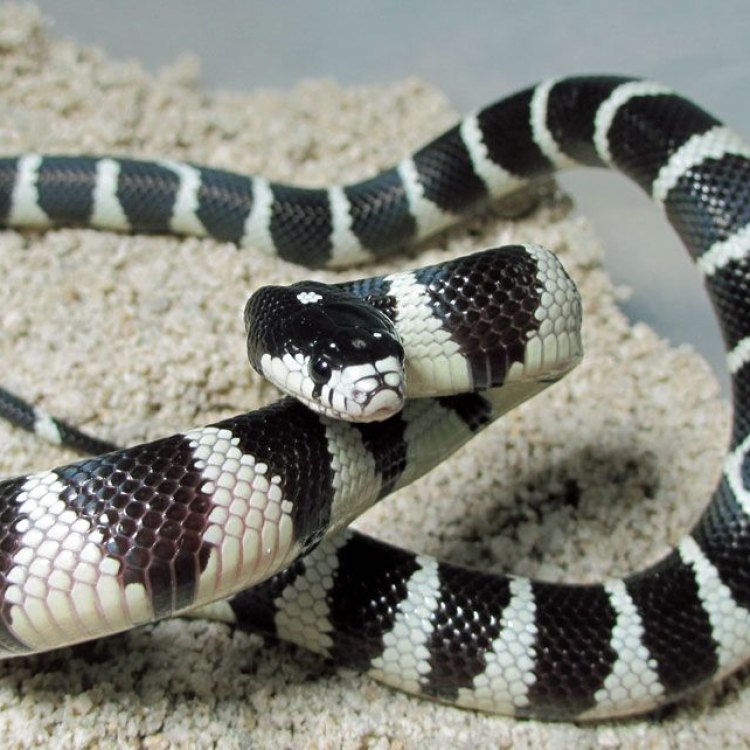
Desert Kingsnake
- Adult Size: 3-4 feet (91-122 cm)
- Average Lifespan: 10-15 years
- Reproduction: Sexual
- Reproductive Behavior: Mating occurs in early spring, with females laying clutches of eggs in summer
- Sound or Call: Produce no vocalizations
- Migration Pattern: No migratory behavior
- Social Groups: Solitary
- Behavior: Nocturnal
- Threats: Habitat loss, pollution, road mortality, and illegal collection for the pet trade
- Conservation Status: Least Concern
- Impact on Ecosystem: Help control populations of prey species
- Human Use: Collected illegally for the pet trade
- Distinctive Features: Distinct banding pattern on the body, smooth scales, and a head that is barely wider than the neck
- Interesting Facts: 1. They are called kingsnakes because they are known to eat other snakes, including venomous species. 2. Desert kingsnakes are excellent climbers and can be seen in low trees or shrubs. 3. They are known to be docile and are popular as pets.
- Predator: Birds of prey, larger snakes, and mammals
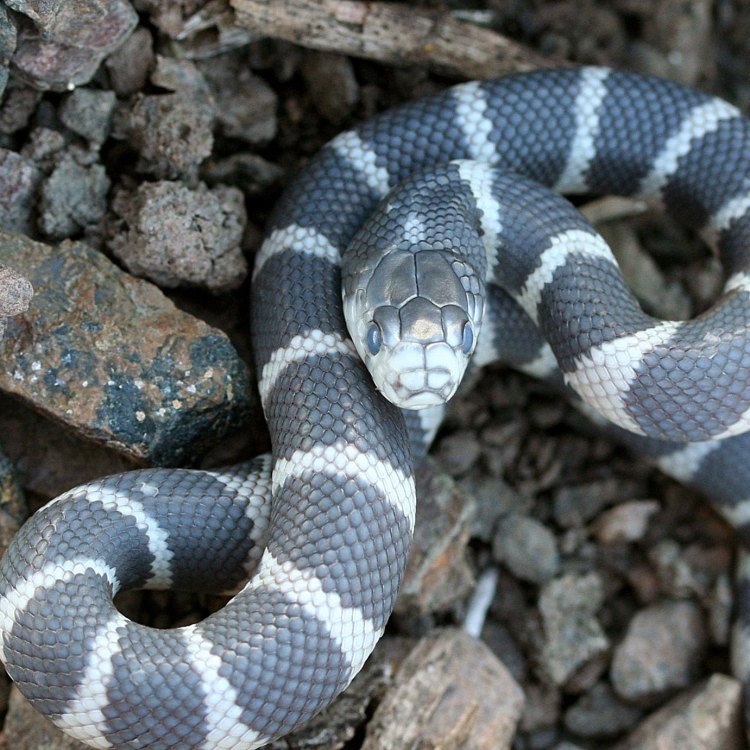
Lampropeltis getula splendida
The Fascinating Desert Kingsnake: Masters of Survival in Extreme Environments
The desert is a harsh and unforgiving environment, with scorching heat, limited resources, and danger lurking at every corner. However, in this seemingly hostile landscape, a fierce and resilient predator thrives – the desert kingsnake.Known for its distinctive banding pattern and remarkable hunting abilities, the desert kingsnake is a master of survival and adaptation. In this article, we will delve into the unique features and fascinating behaviors of this remarkable reptile PeaceOfAnimals.Com.
Size and Lifespan
The desert kingsnake is a medium-sized snake, measuring between 3 to 4 feet (91-122 cm) in length. They are sleek, slender snakes with smooth scales that allow them to move effortlessly through the harsh desert terrain.With proper care, these snakes can live up to 10-15 years in captivity, but in the wild, their lifespan may be shorter due to various threats.
Reproductive Behavior
Desert kingsnakes have a sexual mode of reproduction, meaning they require both male and female to reproduce. During early spring, males actively search for potential mates, and their courtship rituals involve intertwining and rubbing their bodies together.After mating, the females will lay clutches of eggs in the summer, usually in underground burrows or beneath rocks, to protect the eggs from the harsh desert climate.
Social Groups and Behavior
These snakes are solitary, preferring to live and hunt alone. They are primarily nocturnal, meaning they are most active at night, but during the cooler months, they may also be active during the day.Desert kingsnakes are also excellent climbers and can be found in low trees or shrubs, using their strong and agile bodies to navigate through the branches in search of prey Dodo.
Distinctive Features
One of the most distinctive features of the desert kingsnake is its banding pattern, which consists of alternating black and white or cream-colored bands along its body. This pattern provides excellent camouflage in the sandy desert landscape, making it difficult for predators to spot them.Moreover, their smooth scales and small heads – barely wider than their necks – also aid in their stealthy movements and hunting strategies.
Interesting Facts
Aside from their unique features, there are also some interesting facts about desert kingsnakes that make them even more fascinating.Firstly, they are called kingsnakes because they are known to eat other snakes – including venomous species such as rattlesnakes. This earned them the reputation of "king of snakes" for their fearless and bold appetites.
Secondly, they are known to be docile and are popular as pets. With proper care and handling, they can become quite tame and make great companions for reptile enthusiasts.
Lastly, desert kingsnakes have a remarkable impact on their ecosystem. They help control populations of prey species, keeping their numbers in check and ensuring a healthy balance in the desert food chain.
Threats to Survival
Unfortunately, despite their remarkable adaptations and crucial role in the ecosystem, desert kingsnakes face several threats to their survival.Habitat loss, caused by urban development, agriculture, and infrastructure projects, has significantly reduced their natural habitat and food sources.
Moreover, pollution, especially from industrial and agricultural chemicals, can also have a severe impact on these reptiles, affecting their reproductive abilities and overall health.
Road mortality, as a result of snakes being hit by vehicles while crossing roads, is also a significant threat, especially in areas where human activity overlaps with their habitat.
Lastly, illegal collection for the pet trade is a significant threat to desert kingsnakes and other reptiles. They are often caught and sold in the black market, contributing to the decline of their wild populations.
Conservation Status
Despite these threats, the desert kingsnake is currently listed as "Least Concern" on the IUCN Red List. This means that their population is stable, and they are not in immediate danger of extinction.However, it is essential to continue monitoring their populations and implementing conservation efforts to ensure their long-term survival in the harsh desert environment.
Conclusion
The desert kingsnake is a fascinating and resilient species that has thrived in harsh and extreme environments for millions of years. Their unique adaptations and behaviors make them a vital part of the desert ecosystem, and their role in controlling prey populations is crucial for maintaining a healthy balance in the food chain.However, it is also essential to recognize and address the threats they face, including habitat loss, pollution, road mortality, and illegal collection. Only through concerted conservation efforts can we ensure the survival of these remarkable reptiles for generations to come.
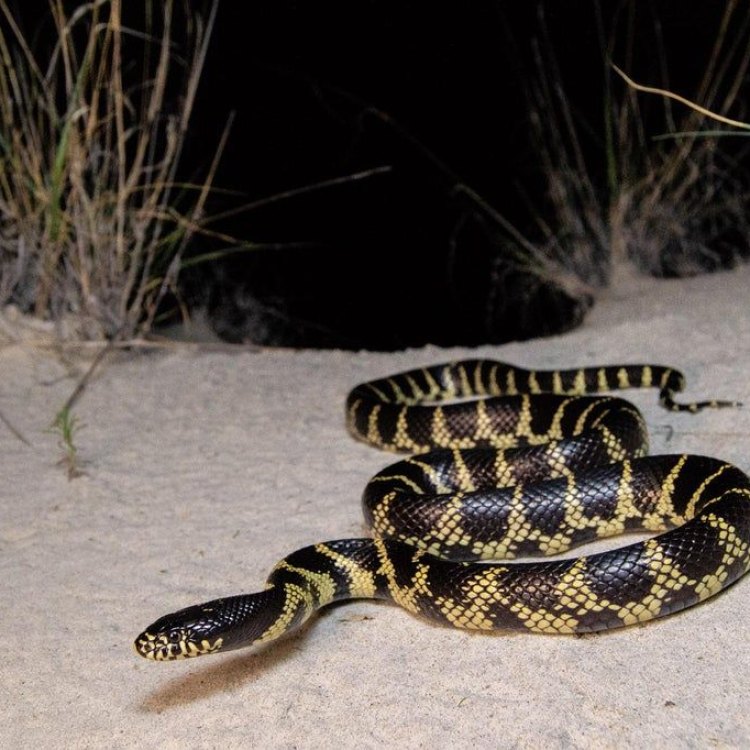
The Majestic Desert Kingsnake: A Closer Look at this Striking Reptile
Disclaimer: The content provided is for informational purposes only. We cannot guarantee the accuracy of the information on this page 100%. All information provided here may change without prior notice.

